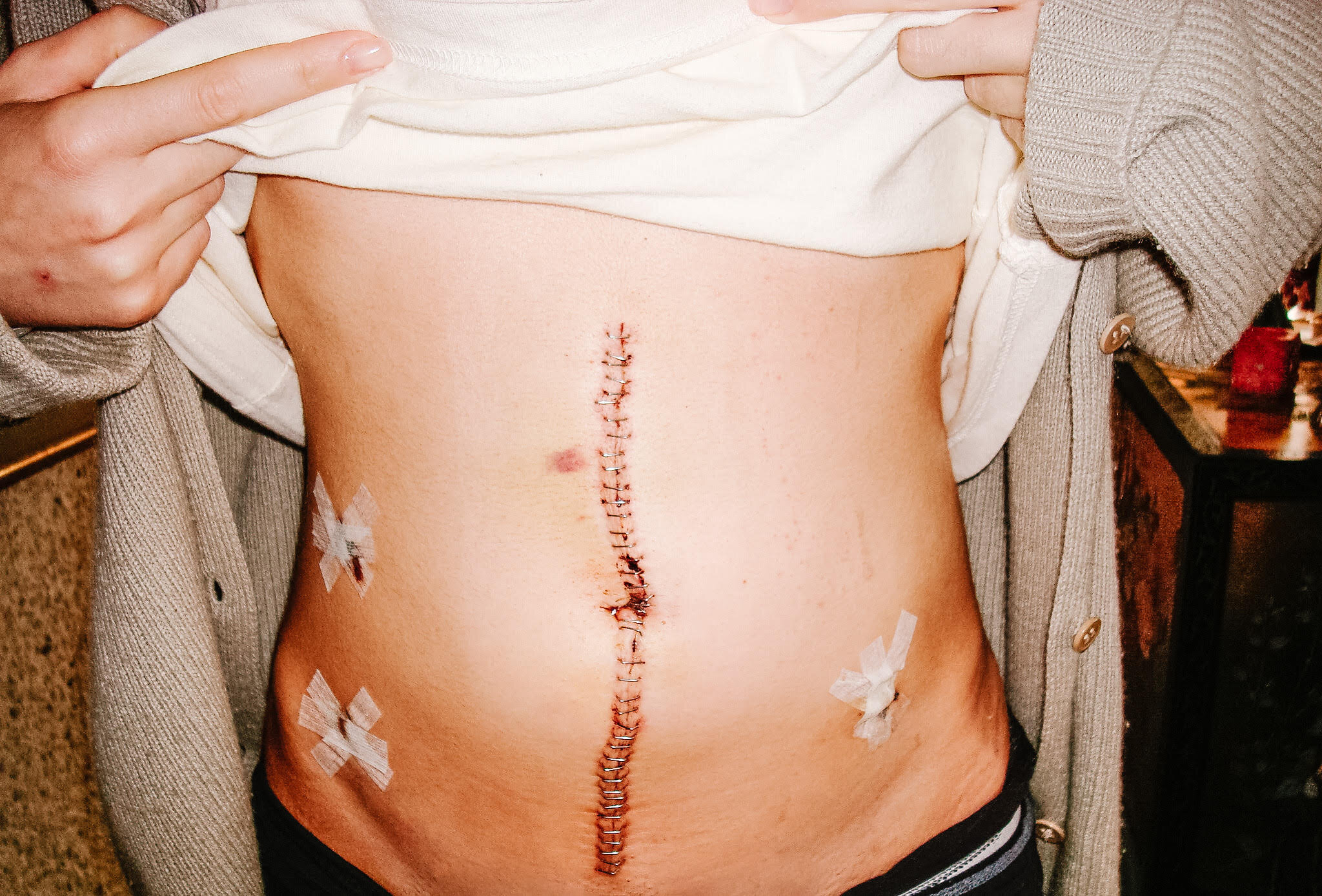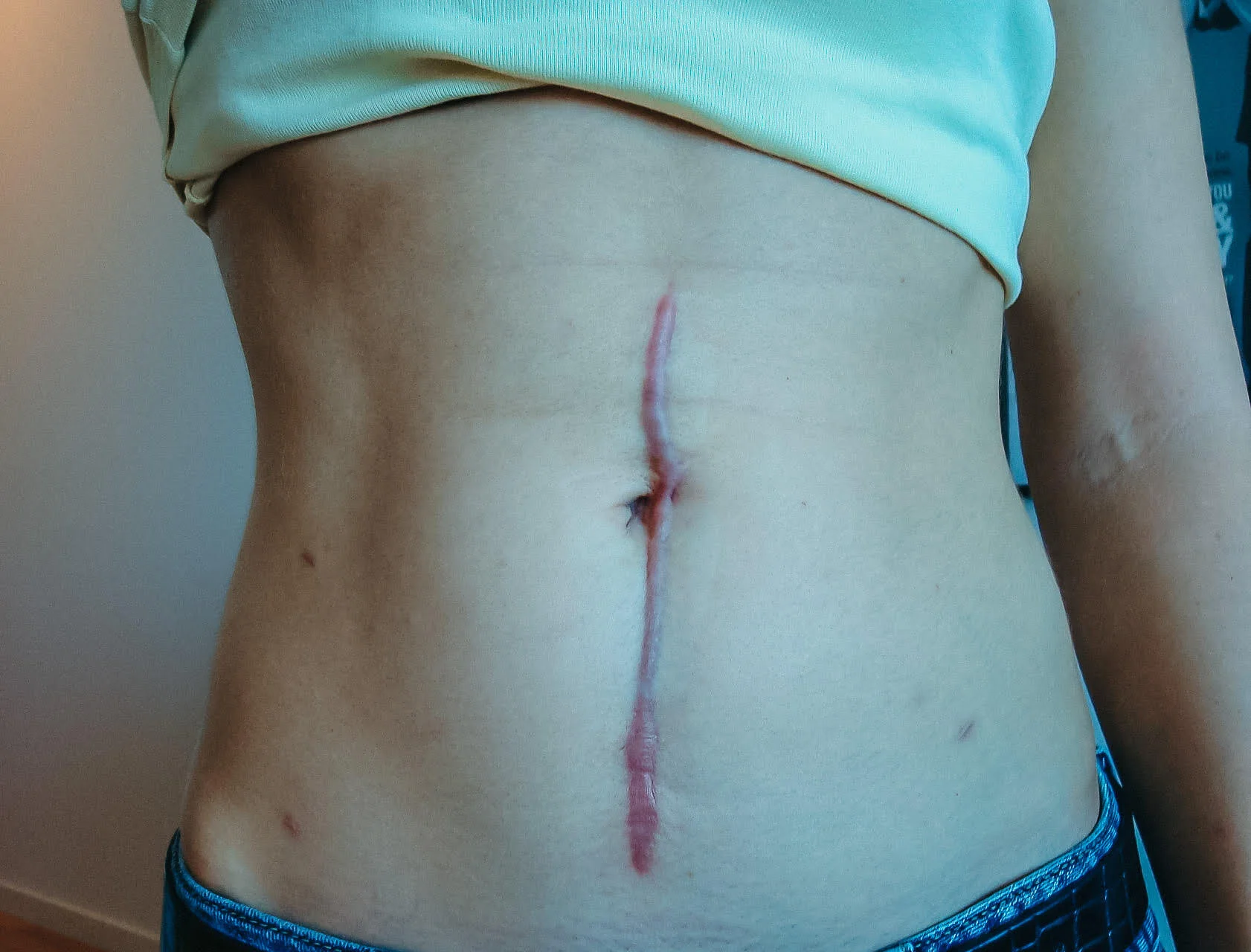My Scar Is A Tattoo That Runs Deeper Than Ink
by Victoria Malloy
Warning: This post contains graphic medical detail and images.
The number 42.
No, it’s not my lucky number, it’s the number of staples I had holding my stomach closed.
I was lying on the operating table getting ready to go under the knife for a quick in-and-out procedure to remove an ovarian cyst. Let me preface that the cyst showed no symptoms whatsoever. I didn’t even know it was there until it was detected on a routine ultrasound for something unrelated. I questioned why we were even removing it at all, but I decided to follow the doctor’s recommendation.
When I awoke from the fog of anesthesia and saw that the clock at the foot of my bed read 4:30pm, I knew something wasn’t right. I should’ve been back at home hours ago.
I can still remember, in vivid detail, how the next few minutes played out.
My mom was standing at my bedside and as she began to explain what had happened, I felt a twinge of pain in my abdomen. When I lifted the top of my gown to look, what I saw shocked me.
A Frankenstein-like row of metal hardware holding my stomach closed like a zipper. There they were, the 42 blood-stained staples running down my stomach from my bra line to my underwear. The surrounding tissue was a spotted patchwork of black and blue bruising. I could barely see my belly button.
My “simple” procedure took a near fatal turn when a misstep (careless blunder? lack of focus? unsteady hand?) with a surgical tool severed a blood vessel. As blood pooled up in my abdominal cavity, what followed was an emergency surgery to hastily repair the bleed. If that wasn’t enough, and as it turned out, the cyst ended up being partially wrapped around one of my fallopian tubes.
One of the first questions I asked was whether I lost a fallopian tube or if it was damaged, thinking about what that would mean for my fertility potential. As luck would have it, the tube was intact, and the cyst successfully removed.
At least one thing worked out.
“it looked like something out of a horror movie, a Frankenstein-like row of metal hardware holding my stomach closed like a zipper. ”
What I felt in the days that followed was a mixed bag of emotions. Above all, I was in a lot of pain. And despite the steady flow of morphine that left me feeling dazed, I was angry.
Angry at the medical profession.
Angry that something I was told was so simple had led to this.
Angry that my doctor seemed indifferent, unsympathetic and unapologetic.
Of course, I recognize and accept that mistakes happen. We all make them. Even doctors, who we regard as superhumans, make them. But I’m still allowed to be mad.
Was I happy to be alive? Of course. But was I angry? Oh yes.
[Warning: graphic image]
I spent a week in the hospital, with a total stranger for a roommate, separated only by a flimsy curtain. I had no TV and limited visitation time since I was staying in the maternity ward.
I couldn’t get out of bed for the first four days. I was isolated, and incredibly vulnerable. I had to listen to the deafening sounds of women in labor, all the while watching the clock inch it’s way closer to visitation time, when I knew I’d have the company of my family.
I felt helpless—hooked up to monitors and IV bags, a catheter inserted, getting bathed with a sponge, and having to practice blowing into a breathing apparatus. When the time came to try walking, it was like learning to use my legs for the first time, all the while trying not to pop a stitch, or in my case, a staple (or four!). I was reminded of the daily things we take for granted, like climbing stairs, long, deep breaths, and sneezing without needing to brace yourself for impact.
A big achievement was when I finally walked to the bathroom by myself, shuffling slowly past my roommate’s bed clutching my gown closed with one hand, and towing my IV pole with the other.
The bathroom had cinnamon flavored mouthwash that tasted like Big Red chewing gum. To this day, I can’t stand the taste of cinnamon.
“was I happy to be alive? Of course. But was I angry? Oh yes.”
On the day of my discharge, the nurse came to my room and handed me an industrial-looking pair of pliers that looked like they were straight out of the movie Hostel.
She said: “Here’s the tool you’ll need to remove your staples.” I was stunned at the suggestion of sitting there extracting 42 staples out of my own stomach one at a time.
I had a long road to recovery ahead of me, but that wasn’t even the hardest thing to come to terms with. It was the fact that at the tender age of 22, my self-esteem had just taken a massive hit. I felt mangled and wondered how this was going to impact my life.
I thought about the clothes hanging in my closet that I’d no longer have the confidence to wear.
I thought about my dating life and intimacy and the reaction it would invite.
I always felt comfortable and confident in my body, but now I had this sizable blemish tarnishing it and I felt uneasy about how it would be perceived. In the dating world, a common getting-to-know-you type question might be: Got any ink? and in my head, I’d say: No. Does this gnarly scar count?
In the months that followed, my scar looked worse as it healed. Not only was it bright red and angry, but it was notably raised and the scar tissue was hard to the touch. It looked like a worm you’d pick up off the asphalt driveway after it rained.
Despite my religious use of oils, creams, and just about anything under the sun labeled “scar reducing,” it maintained its gruesome appearance for a good seven years or so before it started to improve.
I felt the need to bring it up early in intimate situations, sparing partners the shock of discovering it themselves. It actually became a great barometer for weeding out the unworthy candidates.
Eventually, its appearance started changing for the better, and so did my attitude towards it. It started to become a story of hardship that I was proud to tell. My self-image evolved as I matured, and I no longer aspired to standards of perfection.
I slowly, slowwwwly, started to think my scar looked almost…cool, and I thought about how inspiring it would be to see real, flawed women grace the cover of magazines. Women who aren’t photoshopped within an inch of their life.
I’ve been told it makes me look badass. I’ll take that, who wouldn’t want to feel badass? I am badass for what I endured.
“it started to become a story of hardship that I was proud to tell. ”
One day I threw caution to the wind and decided I was going to start putting it out there for all to see. I was heading to a pool club and thought, what better opportunity to test the waters. I dug out an old bikini buried at the bottom of my drawer and took the leap.
While I was a bit skittish at first, I found myself oddly enjoying seeing people take notice. I figured they must be conjuring up scenarios of how I got it. I wasn’t exactly walking tall like my pre-scar self, but it was the first step in the right direction.
Fast forward 15 years and my scar has settled nicely into the tone of my skin. It’s still very much there, but it no longer sticks out like a sore thumb.
What was once a symbol of trauma and insecurity, is now a symbol of strength. The marker of a challenge conquered. It is a tattoo that holds so much more meaning and runs far deeper than ink.
My body and mind were put through the ringer and I have the scar to prove it. A scar that makes me one of a kind and that I sport with pride.
I often wonder how different I might be, had I not had this experience and the lessons that came with it.
Would I feel as strong? Would I be as resilient? Would I like myself as much as I do now?
I don’t know. Part of me thinks…probably not.
This article is for informational purposes only. It is not intended to be used in place of professional advice, medical treatment, or professional care in any way. This article is not intended to be and should not be a substitute for professional care, advice or treatment. Please consult with your physician or healthcare provider before changing any health regimen. This article is not intended to diagnose, treat, or prevent disease of any kind. Read our Terms & Conditions and Privacy Policy.




